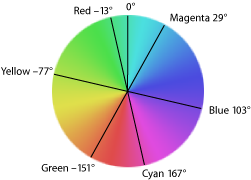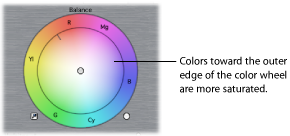The YʹCbCr Color Model
In the RGB color model, all three channels contribute to the perception of brightness. In the early 1950s, this was a problem when developing a three-channel color television system that would be compatible with existing black-and-white televisions. The solution was to encode a single channel that represented luminance—light intensity as perceived by humans—which existing black-and-white televisions could decode. Color televisions would receive the same luminance channel and two additional color channels that could be decoded back into RGB color for display.
The UV representation of chrominance was chosen over straight R and B signals because U and V are color difference signals. This meant that in a black and white scene the U and V signals would be zero and only the Y’ signal would need to be transmitted. If R and B were to have been used, these would have non-zero values even in a B&W scene, requiring all three data-carrying signals. This was important in the early days of color television, because holding the U and V signals to zero while connecting the black and white signal to Y’ allowed color TV sets to display B&W TV without the additional expense and complexity of special B&W circuitry. In addition, black and white receivers could take the Y’ signal and ignore the color signals, making Y’UV backward-compatible with all existing black-and-white equipment, input and output. It was necessary to assign a narrower bandwidth to the chrominance channel because there was no additional bandwidth available. If some of the luminance information arrived via the chrominance channel (as it would have if RB signals were used instead of differential UV signals), B&W resolution would have been compromised.
Luminance
Luminance is a measure of physical light intensity modified by the spectrum sensitivity measured in human vision. In other words, red, green, and blue contribute to the perception of brightness, but not equally. Since two of the cone cell types in the eye favor light in the green portion of the spectrum, the luminance channel is weighted to mostly represent the green color channel. This makes the luminance channel appear to have the equivalent brightness that we see in a color image.
The YʹCbCr color model derives luminance from the Commission Internationale de l’Eclairage (CIE) XYZ color system, in which the Y component represents luminance (X and Z represent color components).
In video systems, a gamma adjustment is applied to the RGB color channels to make efficient use of the bandwidth available for carrying and recording signals. The gamma-adjusted channels are called R′G′B′, and the derived black-and-white channel is called Yʹ, or luma.
Luma
Luma describes the brightness of video, from absolute black, through the distribution of gray tones, all the way up to the brightest white. Luma is completely separate from the color of your video. In fact, if you viewed the luma of a video clip by itself, you would see a grayscale image completely devoid of color.
Luma is measured by Final Cut Pro as a digital percentage from 0 to 100, where 0 represents absolute black and 100 represents absolute white. Final Cut Pro also allows you to see super-white levels (levels from 101 to 109 percent) if they exist in your clip. Although super-white video levels are not considered to be broadcast-safe, many consumer camcorders record video at these levels anyway.
Note: In analog video, luma is measured in IRE units. These IRE measurements are irrelevant in Final Cut Pro because it deals only with the digital signal that exists in your computer as a straight percentage from 0 to 100 for NTSC and PAL video.
About Gamma
Gamma is an implicit or explicit transfer function that maps input intensity to output intensity, usually in a nonlinear way. The most common example is a CRT monitor, where the brightness onscreen is less than expected based on the input voltage. If the input voltage ranges between 0 (black) and 1 (white), one would expect a voltage of 0.5 to generate a brightness value of about 50 percent gray on the screen, but in fact only 18 percent gray is generated. This is simply the nature of a CRT’s electron gun response to input voltage.
The CRT applies an implicit power function in which the input signal is raised to the power of 2.5 (V2.5). Gamma is usually defined by the value of the exponent in the power function—in this case, 2.5.
Keep in mind that in most computer systems, images are encoded with a gamma of about 0.45 and decoded with a gamma of 2.2; a notable exception, until the release of Mac OS X 10.6 (Snow Leopard) in September 2009, were Macintosh computers: they used 0.55 and 1.8 respectively. In any case, binary data in still image files (as JPEG) are explicitly encoded (that is, they carry gamma-encoded values, not linear intensities), as are motion picture files (such as MPEG). The system can optionally further manage both cases, through color management, if a better match to the output device gamma is required. Monitor your images with an external Monitor please.

Color Difference Channels
The color channels, CB and CR, are derived by subtracting Y from the R and B signals and are sometimes referred to generally as B-Y and R-Y, or color difference channels. Analog video systems such as Betacam SP use PB and PR channels, and digital video systems use CB and CR. Each color channel format performs the same function, but the underlying specifications are slightly different.
In digital video, the color channels are typically sampled less often than the luma channel, reducing the video data without noticeable loss of image quality. The ratio of sampling between the YʹCBCR channels is often written as 4:2:2, 4:1:1, and so on, depending on the sample rates used.
Chroma
Chroma describes the color values in your clips, ranging from the absence of color to the maximum levels of color that can be represented. Chroma has two properties, hue and saturation.

Hue
Hue describes the actual color itself, whether it’s red or green or yellow. Hue is measured as an angle on a color wheel.
Saturation
Saturation describes the intensity of a color, whether it’s a bright red or a pale red. An image that is completely desaturated has no color at all and is a grayscale image. Saturation is also measured on a color wheel, but as the distance from the center of the wheel to the edge.
As you look at the color wheel, notice that it is a mix of the red, green, and blue primary colors that make up video. In between these are the yellow, cyan, and magenta secondary colors, which are equal mixes of the primary colors. These colors are most intense at the outer rim of the wheel and gradually desaturate to pure white at the center, indicating the absence of color.
This information was reproduced here from Wikipedia and Final Cut Pro Online Help Documentation.


